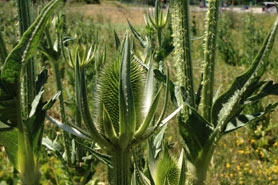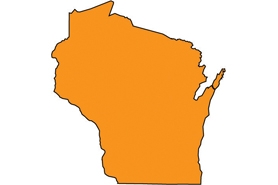Common teasel
(Dipsacus fullonum)
Herbaceous, monocarpic perennial. Grows as a basal rosette for at least one year. Forms a prickly, angled flowering stalk, 2-6' tall, typically in the second or third year.
Other names for this plant include:
- Common names: Fuller's teasel, wild teasel
- Scientific names: D. fullonum ssp. fullonum; D. fullonum ssp. slyvestris; D. sylvestris
Classification in Wisconsin: Restricted
- Ecological Threat
-
- Invades open areas, prairies, savannas, sedge meadows, roadsides, and disturbed areas.
- Rapid range expansion of cut-leaved teasel has been observed in several midwestern states.
- Identification
-
Leaves: Opposite, large (up to 1.5' long), oblong, and prickly. Leaves of flowering plants join into a cup around the stem. Typical teasel leaves are not lobed.
Flowers: Hundreds of tiny flowers clustered in dense, egg-shaped heads. Stiff, spiny, leaf-like bracts curve up from the base of the flower head. Common teasel has purple flowers and bracts longer than the flower heads—common blooms from June-October.
Fruits & seeds: Each plant can produce as many as 2,000 seeds. Seeds remain viable in the soil for at least two years.
Roots: Deep taproot, up to 2' long and 1" in diameter.
Similar species: Cut-leaved teasel (Dipsacus laciniatus) leaves are broader and have deep, feathering lobes. Its bracts are shorter than the flower heads. The flowers are white and bloom from July-September.
- Control
- Mechanical: Rosettes can be dug up making sure to remove as much of the root as possible. Mature plants can be cut in complete bud stage; the plant will re-sprout but will not flower. Bag and dispose of stems—late spring burns.
Chemical: Foliar spray with triclopyr, clopyralid, aminopyralid, or metsulfuron before the plant has bolted. Spray rosettes in fall with glyphosate.
For more information on control techniques, visit the Teasels factsheet [exit DNR] by the University of Wisconsin-Extension.
- Resources
- Sources for content:
- Czarapata, Elizabeth; Invasive Plants of the Upper Midwest: an illustrated guide to their identification and control. The University of Wisconsin Press. 2005. Pg. 59-61
- University of Wisconsin-Extension Weed Science


